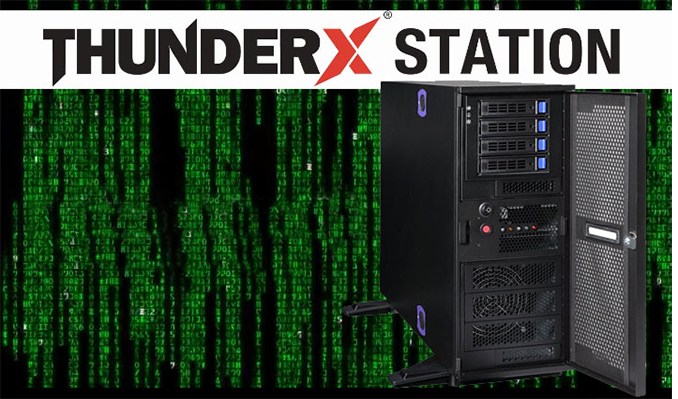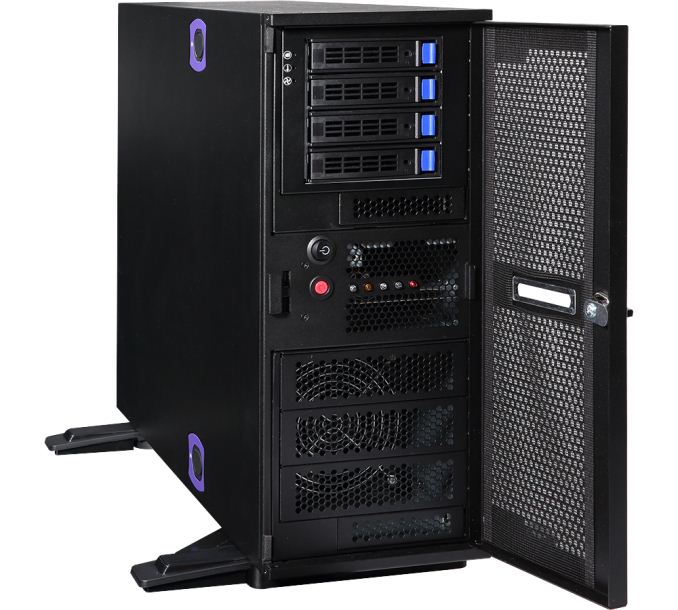GIGABYTE's ThunderXStation with Dual Cavium ThunderX2 Arm SoCs
by Anton Shilov on March 27, 2018 7:30 AM EST- Posted in
- Workstation
- Systems
- Gigabyte
- Arm
- ARMv8
- Cavium
- ThunderX
- ThunderXStation

GIGABYTE this month introduced its ThunderXStation workstation based on two Cavium ThunderX2 processors featuring Armv8 architecture. The machine is primarily aimed at software developers porting or developing various applications to Armv8 platforms. The ThunderXStation is already available in the US.
GIGABYTE's ThunderXStation (W281-T90) comes in 4U tower and is based on a dual-socket motherboard supporting Cavium’s ThunderX2 SoCs featuring up to 64 custom Armv8 cores with four-way SMT as well as 16 DDR4 memory channels (1DPC, 8 channels per SoC) when two CPUs are installed. A dual-processor ThunderXStation comes with two PCIe Gen3/OCP x16 slots, four PCIe Gen3 slots (two x16 and two x8), four M.2 (NVMe/PCIe 3.0 x4) slots for SSDs, two U.2/SATA 2.5” bays for SSDs/HDDs, two 10 GbE/GbE QLogic NICs, NVIDIA’s GeForce GT 710 GPU, an 800 W redundant PSU and so on.

Image from ServeTheHome from OCP Summit 2018
From hardware standpoint, the ThunderXStation looks rather versatile: it supports various expansion slots, enabling developers to use various add-on cards, accelerators, and storage devices required by their applications. The system also has an Aspeed AST2500 server management chip to bring it even closer to target machines that will run the ThunderX2.
The ThunderXStation ships with Ubuntu 17.10 OS, but can come with CentOS 7.4 or OpenSUSE, if required. It also comes with preinstalled software development tools, including gcc 7.2, LLVM, gdb, Golang, OpenJDK 9.0, HHVM, Python, PHP, Ruby etc. The OS supports KVM and Docket to enable developers to test their apps in hypervisor-based or containerized environments. The machine ships with open sources graphics drivers, primarily because it comes with a GeForce GT 710 graphics card (so, open source drivers should be reasonably good for such an old architecture).
| GIGABYTE's ThunderXStation | |
| Preliminary Specifications | |
| CPU | Dual or single Cavium ThunderX2 2.2 GHz CPU with 32 cores |
| GPU | NVIDIA GeForce GT 710 |
| Memory | 8 × DDR4-2666 DIMM slots per CPU |
| Storage | 2 × M.2 slots for PCIe/NVMe SSDs |
| 2 × 2.5" SATA/U.2 bays | |
| Wireless | unknown/none |
| Ethernet | 1 × Gigabit Ethernet, can be outfitted with 10 GbE cards |
| PCIe | 1 × PCIe Gen 3/OCP x16 per CPU 2 × x16/x8/x4/x1 and x8 per CPU |
| Display Outputs | 1 × D-Sub for management Others via discrete graphics |
| Audio | unknown |
| USB | 4 × USB 3.0 Type-A |
| PSU | 800 W redundant |
| OS | Ubuntu 17.10. CentOS 7.4 or OpenSUSE |
One of the reasons why contemporary Armv8 SoCs are rarely used in datacenters is lack of software support. Developers need to recompile their programs for Arm, but since very few have access to hardware and appropriate tools, the software porting process is proceeding very slowly. GIGABYTE’s ThunderXStation will enable more parties to work on server programs for Arm platforms. This is similar to how Intel approached the Xeon Phi ecosystem, by launching a tower equivalent with a Knights Landing machine with the Xeon Phi chip as the host for development work.
The Armv8-based workstation for software developers is now available from PhoenicsElectronics in the U.S. GIGABYTE does not publish pricing of the ThunderXStation, but we have reached out to PhoenicsElectronics and will update the story once we get more information on the matter.
Related Reading
- Marvell to Acquire Cavium for $5.5 Billion, Augmenting Marvell's CPU, Networking, & Security Assets
- Investigating Cavium's ThunderX: The First Arm Server SoC With Ambition
- AppliedMicro's X-Gene 3 SoC Begins Sampling: A Step in Arm's 2017 Server Ambitions
- MACOM Sells AppliedMicro’s X-Gene CPU Business
- Arm Challenging Intel in the Server Market: An Overview
- Supermicro Releases Intel Xeon Phi x200 (KNL) Systems: Servers and a Developer Mid-Tower
Sources: Cavium, ThunderXForums, Liliputing











23 Comments
View All Comments
deepblue08 - Tuesday, March 27, 2018 - link
Is this what Neo uses?stanleyipkiss - Tuesday, March 27, 2018 - link
GeForce 710 ?jordanclock - Tuesday, March 27, 2018 - link
Sure. Why not? It just needs some basic video output and those cards are dirt-cheap with fine Linux support.eSyr - Tuesday, March 27, 2018 - link
Not really, it should work perfectly fine with output via serial.tuxRoller - Wednesday, April 4, 2018 - link
The ast2500 includes a well supported (Linux & Windows) vga controller.HStewart - Tuesday, March 27, 2018 - link
My guess it because the bus on it will not allow higher end boards - I have Xeon 5160 and highest GPU card I can go with is GeForce 740 PCIe.MrSpadge - Thursday, March 29, 2018 - link
You can fit any current PCIe 3 card into even PCIe 1 slots, as long as it physically matches.Elstar - Tuesday, March 27, 2018 - link
Is it just me, or did they merely retrofit their rack mount motherboard into a desktop case?jordanclock - Tuesday, March 27, 2018 - link
Appears that way, which makes sense for a dev platform. Why spend the resources on building a new mobo and all when you can just make some small changes and put it on its side?mode_13h - Wednesday, March 28, 2018 - link
Disappointing. I was really expecting ARM-based PCs to be a thing, by now.